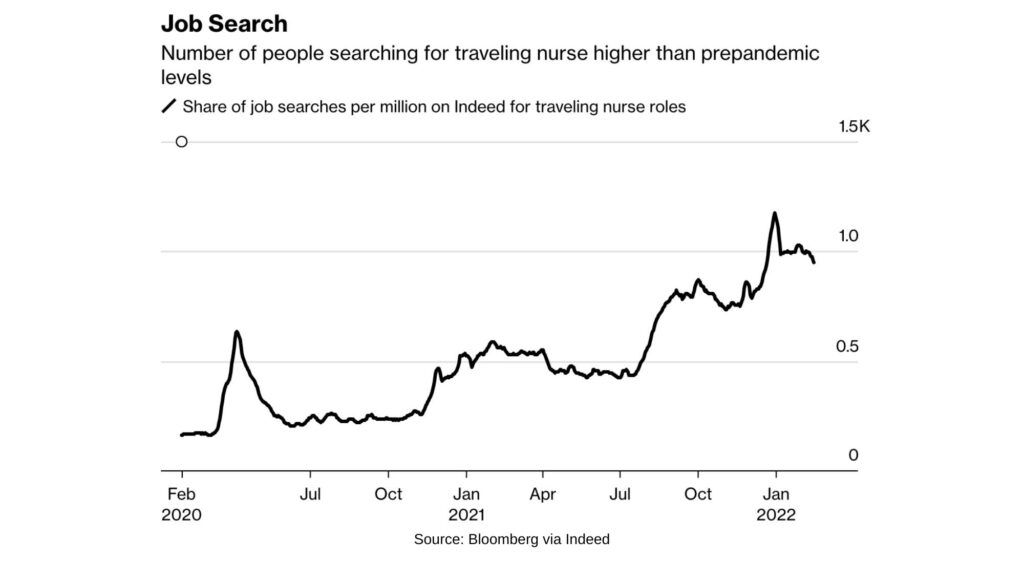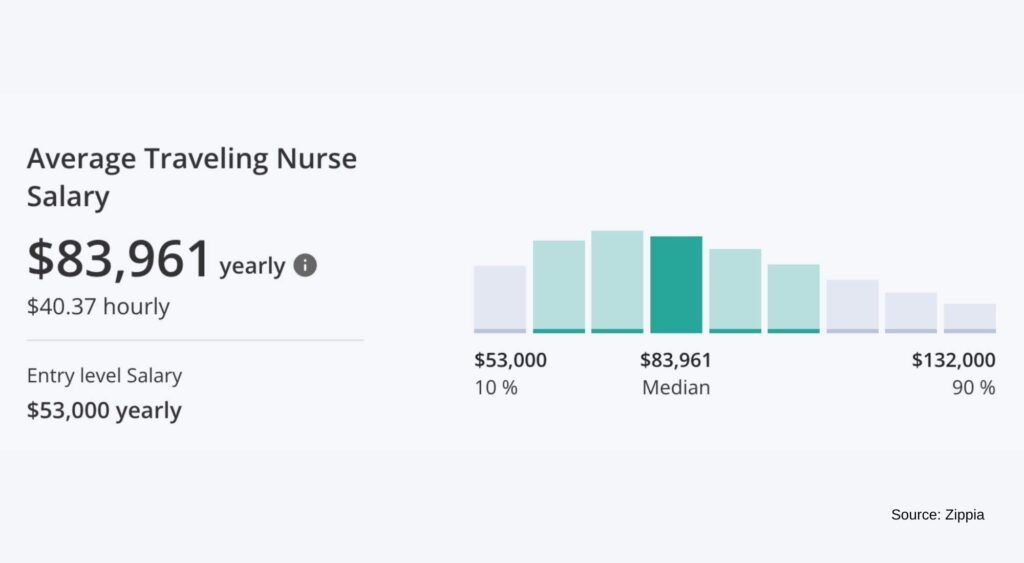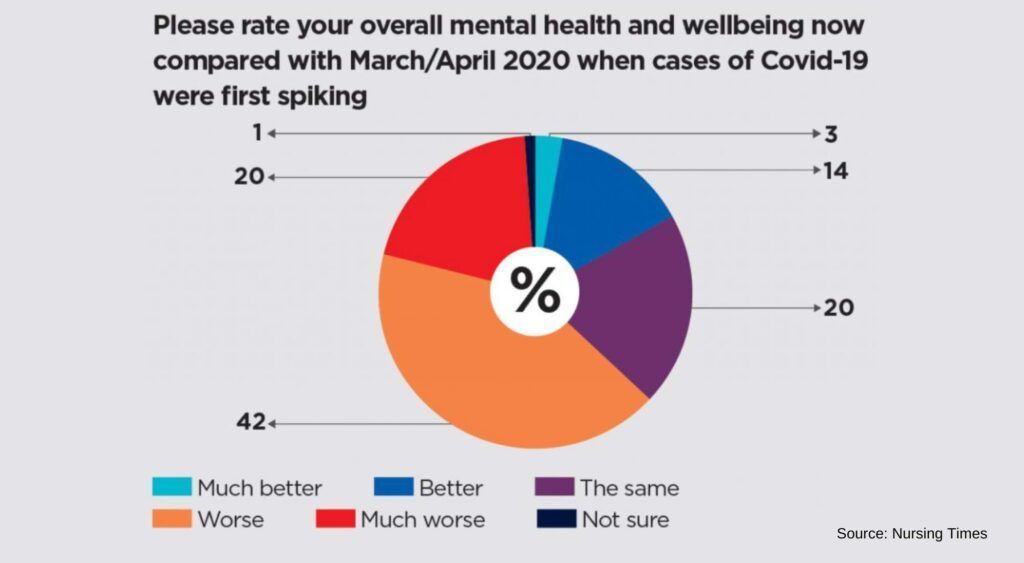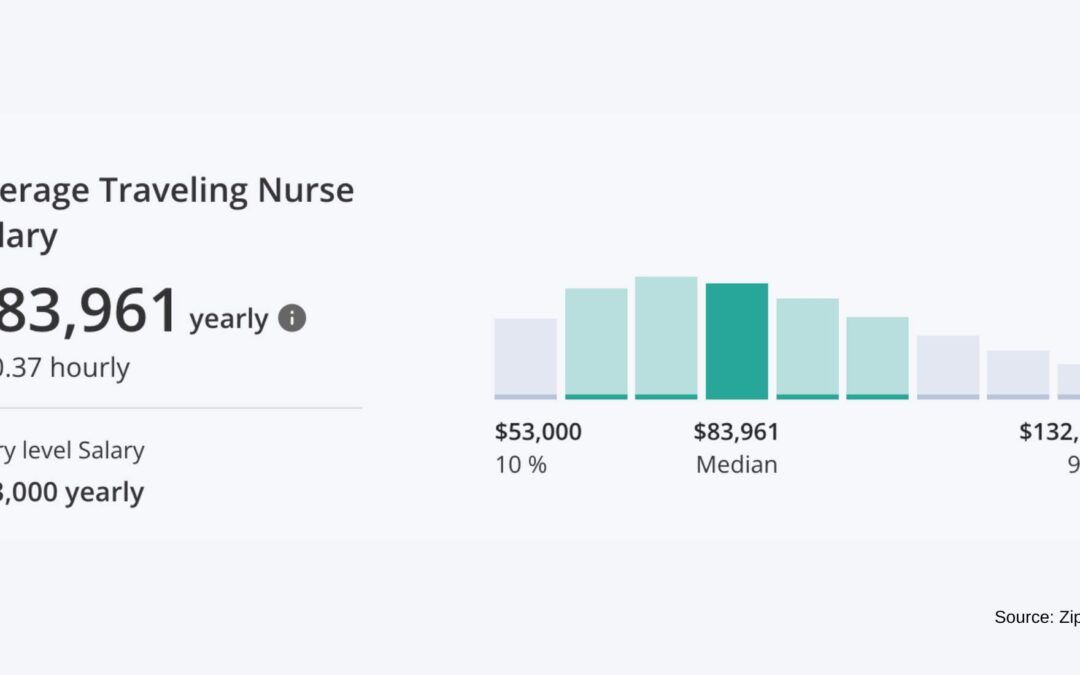Staffing shortages have kept the need for travel nurses a hot topic since the pandemic in 2020.
With a high demand for nurses, we might expect the coming years to continue offering higher salaries and new opportunities for travel nurses to work short-term contracts around the country.
Unfortunately, since 2020, burnout and lack of personnel have led many hospitals to seek more help. By staying on top of the many travel nursing trends — from salary to how to handle mental health to an increase in job opportunities and more — you can stay ahead of the game and better prepare for the future of an often challenging career.
Learn what travel nurse statistics tell us about the future of travel nursing this year and beyond.
Table of Contents
- Travel Nursing Statistics: Where Does the Data Come From?
- Pay Attention to These 3 Big Travel Nursing Trends
- 7 Additional Trends We’re Predicting for the Travel Nurse Industry in the Coming Years
- Take Advantage of Future Travel Nursing Trends With Trusted Nurse Staffing
Travel Nursing Statistics: Where Does the Data Come From?
Many resources work hard to gather data used to help healthcare professionals understand the trends of their jobs. For travel nursing, statistics are gathered from a variety of places.
Every two years, the National Council of States Boards of Nursing (NCSBN) partners with The National Forum of State Nursing Workforce Centers and conducts a survey focused on the nursing profession. The most recent National Nursing Workforce Survey was done in 2022 and generated information on the supply of nurses in the country.
The findings included things like:
- The median age of RNs was 46
- Male RNs have steadily increased
- Most RNs (57.5%) work in a hospital setting
- The median pre-tax earnings for RNs is $80,000
- Over 60% of RNs reported an increase in their workload since the COVID-19 pandemic
COVID-19 impacted many jobs throughout the United States, but nurses and other medical professionals saw a huge change that altered the way the profession would be in the years following the pandemic.
The Impact of COVID-19 on Travel Nursing
Demand for travel nurses soared in 2020 and 2021 due to the crisis caused by the pandemic. According to data from the American Hospital Association, the percentage of total hours worked by contract or travel nurses in hospitals grew from 3.9% in January 2019 to 23.4% in January 2022.
Additionally, hospitals spent about 4.7% of their nurse labor expenses on travel nurses in January 2019, while in January 2022, that average reached 38.6%. This increase illustrates the boost the travel nurse profession has seen over the past couple of years.
Since the onset of the COVID-19 pandemic, the 2022 National Nursing Workforce Study represents the largest, most comprehensive, and most rigorous evaluation of the nursing workforce. This survey concluded that approximately 100,000 RNs and 34,000 licensed practical and vocational nurses have left the workforce since 2020.

Pay Attention to These 3 Big Travel Nursing Trends
Although travel nurse statistics show that many things require change in the coming years, three big travel nursing trends jump out — demand for travel nurses, pay for travel nurses, and how the mental health of travel nurses is approached.
Demand Trends in Travel Nursing
Many travel nursing specialties are topping the charts for most demand by healthcare facilities between January and March 2023.
According to report results, these travel nurse specialties are in demand:
- Med-Surg – 17% demand
- Emergency department – 8% demand
- Step-down – 7% demand
- Med-Surg/telemetry – 6% demand
- Medical ICU – 5% demand
- Telemetry – 5% demand
- Operating room – 5% demand
- Labor and delivery – 2% demand
- Rehabilitation – 2% demand
- Psychiatry – 2% demand
The analysis also notes that of all U.S. states, Texas has the most (7%) travel nursing jobs available, likely because it’s a compact state, which means it allows travel nurses to obtain a multi-state license and speeds up the credentialing and employment process for them.
These states followed with the most travel nursing jobs available in the United States:
- California – 6%
- New York – 6%
- Florida – 5%
- Massachusetts – 4%
- Pennsylvania – 4%
- Illinois – 4%
- North Carolina – 4%
- Maryland – 3%
With some percentage of travel nursing jobs still available in these states, it’s clear that healthcare facilities continue to struggle to fill their permanent positions. With this, a reliance on travel nurses will continue to grow.
Pay Trends in Travel Nursing
Before the pandemic, travel nurses made an average of between $1,800 to $2,600 a week. During the pandemic, this number grew to between $8,000 to $10,000 a week.
In 2022, the average salary for new travel nurses was just under $84,000 a year. ZipRecruiter reports that in 2023, the national travel nurse salary is just over $105,000 a year.
Yet, it’s also reported that travel nurse salaries can float around $200,000 a year as the need for nurses continues to grow.
A 2022 report shows that as turnover rates for nurses continue to rise, and the fact that it takes roughly three months to fill a new nurse position, the need for travel nurses is even greater. With high demand comes higher pay.
Pay for travel nurses depends on many things, one being where in the United States you accept a travel nurse contract. ZipRecruiter reports that in 2023, the highest hourly paid states for travel nursing are:
- New York – $61.67
- New Jersey – $53.28
- Wisconsin – $52.95
- Nevada – $52.50
- Wyoming – $52.49
- Massachusetts – $52.40
- Indiana – $51.79
- Arizona – $ 51.77
- New Hampshire – $51.73
- Pennsylvania – $51.58
And the lowest-paying states were reported as follows:
- Kansas – $43.09
- Michigan – $42.76
- Louisiana – $42.56
- Missouri – $42.47
- Texas – $42.23
- Nebraska – $41.24
- Idaho – $40.99
- Kentucky – $39.73
- North Carolina – $39.7
- Arkansas – $39.04
When compared to RNs with permanent positions, travel nurses are making more, and there are many travel nursing job opportunities available.
If you’re hoping to take advantage of competitive salaries, Trusted Nurse Staffing can help you find a travel nurse contract that works for you. You can also utilize Pronto to search for current available positions.

Mental Health Trends in Travel Nursing
Amid the pandemic, the mental health of medical staff across the board suffered. Because the pandemic was intensified by a lack of personnel, the fact that many healthcare facilities were not crisis-ready, and inadequate emotional backing, healthcare professionals have been leaving their careers in droves.
Many issues causing the drop in medical staff, including nurses, have been associated with:
- Stress
- Exhaustion
- Trauma
- Lack of support
With the mass exodus in nursing, it became evident that something needed to change. For nurses to provide top-notch care to their patients around the clock, they need to be prioritized — especially their mental health.
If you find yourself struggling with mental health as a travel nurse, consider some of these options that will become widely available in 2023 and beyond:
- Join a support group
- Attend therapy, in-person or virtual
- Meditate
- Utilize sleep relaxation apps
- Exercise regularly
- Practice gratitude daily
- Journal
- Confide in family or friends
- Seek professional help
- Take breaks when necessary
- Share or talk about work traumas
- Join an employee assistance program (EAP)
There are many resources available to the nursing community — including the ANA and American Nurse Foundation’s Well-Being Initiative — to help avoid both mental and physical burnout. Once you recognize the triggers, you can help prevent it from happening time and time again.

7 Additional Trends We’re Predicting for the Travel Nurse Industry in the Coming Years
As a travel nurse pondering the future of your career, there are many trending factors to consider.
Remember, travel nursing statistics show that a career as a travel nurse is in demand. In 2020, travel nursing grew by 35% and it hit a 40% growth in 2021. Will this trend continue as permanent RN positions are still left open throughout many healthcare facilities?
If you choose to take on a career as a travel nurse, what could you expect for the future?
#1: An Increase in Travel Nursing Within Hospitals
More hospitals and healthcare facilities are offering internal travel nurse programs as a way to help combat the staff nursing exodus they’ve been experiencing over recent years.
As travel nursing has become increasingly more popular (thanks to its many benefits), paired with the effects of the pandemic on healthcare professionals, many hospitals have begun to lose their staff nurses.
Now, many large healthcare facilities are launching travel nurse programs, offering short-term and high-paying contracts to travel nurses. Some even offer limited benefits.
For a nurse looking to try out a short-term contract or who wants more flexibility in your work schedule while still remaining local, an internal travel nurse program is a great option that benefits both you as a nurse and the healthcare facility.
#2: An Increase in Flexibility
With the pandemic also came telemedicine and travel nursing to the forefront of society — and it looks like they’re both here to stay. These two nursing professions offer great flexibility to a nursing career.
Telenursing provides care through technology, allowing nurses to practice their careers remotely with much flexibility.
Travel nurses get to choose (to an extent) where they want their next assignment to be, allowing them to spend time in different places, experience new locales, and get a feel for different areas of the country. They also can easily take time off between contracts or sometimes have the option to extend a contract if that works best for their lifestyle.
#3: A Steady Number of Opportunities in Nursing
As mentioned earlier, the demand for travel nurses is high. And many different nursing specialties need nurses.
Between 2020 and 2030, the U.S. Bureau of Labor Statistics estimates that there will be around 194,500 annual openings for RNs — an 8% growth rate over the decade.
But the demand for nurses doesn’t just come from RNs leaving their positions.
With the median age of RNs in 2020 being 52 years old, many were/are on the brink of retirement. It’s estimated that one-fifth of the RN population will retire by the end of the decade.
Whether you’re a med-surg nurse, an ER nurse, or a labor and delivery nurse, there are and will continue to be many travel nurse contracts available for you to pursue.
#4: A Growing Demand for Home Health Care Travel Nurses
Today, there are around 46 million baby boomers — adults aged 59 to 77. An Aging in the United States report says that by 2060, this number is expected to be more than 98 million. That’s a dramatic increase!
Because of this increase, it’s expected that about 75% of Americans will need care in a nursing home, offering many opportunities for travel nurses to work outside of a traditional hospital.
#5: A Growing Demand for Behavioral Health Travel Nurses
As a behavioral health nurse, you typically care for patients with behavioral and mental health conditions or substance abuse disorders.
Unfortunately, opioid addictions and suicide rates are rising, and people need help.
In 2023, the percentage of adults in the United States with any mental illness is 21%. The percentage of adults with substance abuse disorder is 15%. Overall, 5% of adults have thoughts of suicide.
The U.S. The Department of Health and Human Services states that by 2025, the U.S. will be 250,000 professionals short of what the demand will require.
#6: Technological Advancements in the Healthcare Profession
Technology is revolutionizing healthcare and the way that medical professionals practice medicine, treat patients, and conduct work regularly.
Travel nurses will begin to see things like:
- Electronic medical record systems
- Telemedicine platforms
- Mobile health apps and devices
- Wearable technologies for patient monitoring
As travel nurses learn to adapt to these many technological advancements in healthcare, many things can change.
#7: Consistency Across the Demographics of Travel Nurses
According to a July 2023 report by Zippia, there are over 1,733,502 travel nurses currently employed in the United States.
Of them:
- About 85% are women while 15% are men.
- The average travel nurse’s age is 43.
- Regarding ethnicity, nearly 70% are White, 12% are Black or African American, 9% are Asian, and 9% are Hispanic or Latino.
As for the future of travel nursing, these numbers are expected to remain consistent, just as they have over the last decade.
Take Advantage of Future Travel Nursing Trends With Trusted Nurse Staffing
Does the future of travel nursing sound promising? With the many job opportunities available, the pay rates, and the chance to travel to new places, why pass up the chance to work as a travel nurse?
Trusted Nurse Staffing works to connect you with rewarding job opportunities that offer great benefits and competitive pay. We are dedicated to helping you achieve your goals which is why we encourage (and help with) continued education, reward success and accomplishments, and help you pursue your growth.
With Pronto, you can search for available travel nursing contracts and work alongside your recruiter at Trusted Nurse Staffing to secure your desired contract with the pay and benefits that you deserve.
Contact us today.

